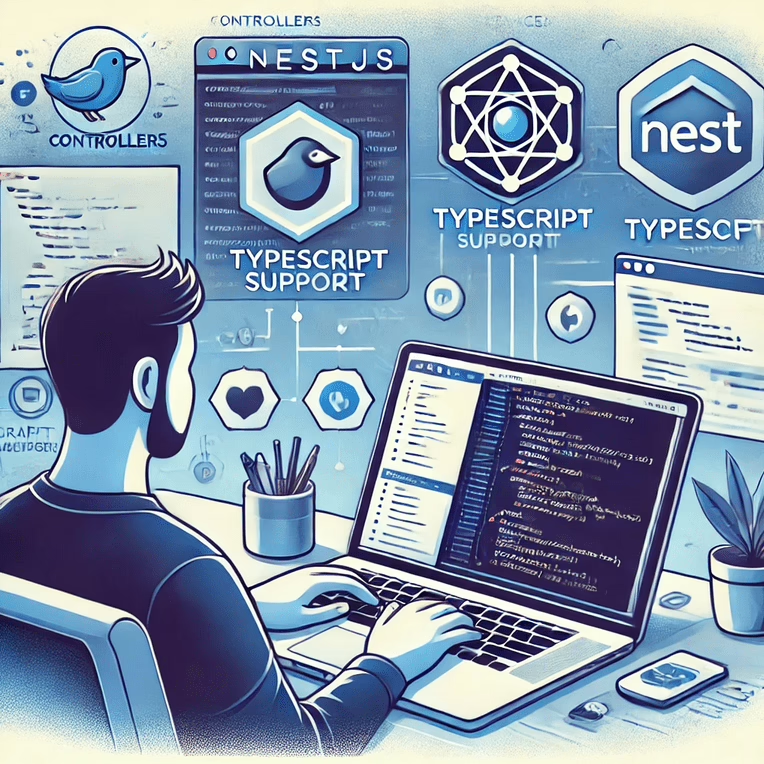In the fast-paced world of web development, creating scalable, efficient, and maintainable server-side applications is crucial. NestJS, a progressive Node.js framework, stands out as a powerful tool that addresses these needs. Leveraging the strength of TypeScript, NestJS provides a robust architectural foundation inspired by Angular, making it an excellent choice for developers aiming to build high-quality server-side applications. This article explores the key features and concepts of NestJS, its benefits, and how Curate Consulting Services can assist enterprises in finding specialized talent to fully leverage this framework.
The Essence of NestJS
NestJS is a progressive framework for building efficient, reliable, and scalable server-side applications. It is built with and fully supports TypeScript, enhancing JavaScript by adding static types. This combination ensures that developers can catch errors early, improve code readability, and maintain a cleaner and more organized codebase.
Modular Architecture
NestJS encourages a modular and organized code structure. The framework is built with a modular architecture, allowing developers to divide their applications into modules. Each module encapsulates related components, controllers, and services, promoting a clear separation of concerns and making the codebase more manageable and scalable.
Express Underneath
NestJS is built on top of the Express.js framework, leveraging its capabilities while adding its own abstractions and features. For developers familiar with Express, transitioning to NestJS is seamless, as they can continue using their knowledge of Express while benefiting from the additional structure and features provided by NestJS.
TypeScript Support
One of the most significant advantages of NestJS is its full support for TypeScript. TypeScript, a superset of JavaScript, introduces static typing, which helps catch errors during development and enhances code readability. Features like interfaces, decorators, and static types enable developers to write more robust and maintainable code.
Dependency Injection (DI)
NestJS uses a powerful dependency injection system that allows components to be injected into each other. This system promotes modular, testable, and maintainable code by reducing dependencies and enabling better organization. Dependency injection makes it easier to manage the lifecycle of services and enhances the testability of the application.
Controllers and Services
NestJS follows a pattern similar to Angular, with controllers handling incoming requests and services containing business logic. This separation of concerns simplifies the management and testing of different parts of the application. Controllers focus on processing HTTP requests, while services encapsulate the core business logic, making the application structure more maintainable and scalable.
Decorators
Decorators are a core part of NestJS and TypeScript. They are used to annotate classes, methods, and properties with metadata, providing additional information to the framework. Decorators play a crucial role in defining routes, injecting dependencies, and more. They offer a clean and declarative way to enhance the functionality of classes and methods.
Middleware
NestJS supports middleware, which are functions executed before or after a request is handled by a controller. Middleware can be used for various tasks, such as authentication, logging, and request processing. This flexibility allows developers to implement cross-cutting concerns in a modular and reusable manner.
Interceptors
Interceptors in NestJS allow developers to run code before or after a method is executed. They can be used for logging, modifying responses, or performing other actions. Interceptors provide a way to wrap the execution of methods, offering additional control over the request-response cycle.
Guards
Guards are used in NestJS to handle access control and authorization. They can be applied to routes to control whether a request is allowed to proceed. Guards are essential for implementing authentication and authorization logic, ensuring that only authorized users can access certain parts of the application.
WebSockets
NestJS includes built-in support for WebSockets through its WebSocket gateway. This feature allows developers to build real-time, bidirectional communication features in their applications. WebSockets are ideal for applications that require live updates, such as chat applications, online gaming, and real-time notifications.
GraphQL Support
NestJS provides robust support for GraphQL, a query language for APIs. Developers can create GraphQL-based APIs using NestJS, benefiting from its modular and organized structure. GraphQL support allows for flexible and efficient data retrieval, making it an excellent choice for applications with complex data requirements.
Testing
Testing is a critical aspect of software development, and NestJS comes with a testing module that facilitates unit testing, integration testing, and end-to-end testing. It includes utilities for mocking dependencies and testing components in isolation, ensuring that the application is reliable and performs as expected.
Real-World Applications of NestJS
NestJS is suitable for building a wide range of applications, including RESTful APIs, microservices, and server-side applications. Its TypeScript support, modular architecture, and Angular-inspired concepts make it a popular choice for developers looking for a scalable and maintainable Node.js framework.
Use Case: RESTful APIs
NestJS excels in building RESTful APIs, thanks to its modular architecture and support for TypeScript. The framework’s powerful routing capabilities, middleware support, and robust dependency injection system make it easy to create scalable and maintainable APIs. Developers can leverage decorators to define routes and middleware for tasks like authentication and logging, ensuring that the API remains clean and efficient.
Use Case: Microservices
Microservices architecture benefits greatly from NestJS’s modularity and dependency injection system. Each microservice can be developed as a separate module, with its own controllers, services, and dependencies. This modular approach simplifies the development, deployment, and scaling of microservices. NestJS also supports messaging patterns like event-driven architecture, making it suitable for building robust microservices ecosystems.
Use Case: Real-Time Applications
Real-time applications, such as chat applications, online gaming, and live notifications, can leverage NestJS’s built-in WebSocket support. The WebSocket gateway allows developers to implement real-time, bidirectional communication features seamlessly. Combined with TypeScript’s strong typing and NestJS’s modular architecture, developers can build high-performance real-time applications with ease.
Use Case: GraphQL APIs
For applications with complex data requirements, NestJS’s GraphQL support is invaluable. Developers can create GraphQL-based APIs that offer flexible and efficient data retrieval. The modular structure of NestJS ensures that the GraphQL schema, resolvers, and services are organized and maintainable. This makes it easier to build and scale GraphQL APIs while maintaining a clean and efficient codebase.
Curate Consulting Services: Your Partner in Leveraging NestJS
At Curate Consulting Services, we understand the transformative potential of NestJS for server-side development. Our team of experts is dedicated to helping organizations harness the full power of NestJS to build innovative and efficient server-side applications.
Finding Specialized Talent
One of the biggest challenges enterprises face is finding specialized talent to implement and manage NestJS applications. At Curate Consulting Services, we have a proven track record of identifying and recruiting top-tier NestJS developers. Our rigorous screening process ensures that we provide our clients with the best talent available, capable of addressing their unique development needs.
Tailored Solutions
We understand that every organization has distinct requirements. Our consultants work closely with clients to understand their specific needs and develop tailored solutions that align with their goals. Whether you need help with building a new application, optimizing an existing one, or scaling your infrastructure, our team is equipped to deliver results.
Continuous Support
Web development is an ongoing process. Our relationship with clients doesn’t end once the initial implementation is complete. We provide continuous support to ensure that your NestJS applications remain performant and up-to-date. This includes regular code reviews, performance assessments, and updates to leverage the latest NestJS features and best practices.
Training and Development
In addition to providing specialized talent, we offer training and development programs to help your in-house team master NestJS. Our training sessions are designed to equip your developers with the skills and knowledge they need to build and maintain high-quality NestJS applications. By investing in your team’s growth, we help you build a sustainable and self-sufficient development ecosystem.
Conclusion
NestJS stands out as a progressive and powerful framework for building scalable and maintainable server-side applications. Its TypeScript support, modular architecture, and Angular-inspired concepts make it an excellent choice for developers looking to create high-quality Node.js applications. At Curate Consulting Services, we are committed to helping organizations unlock the full potential of NestJS. By providing specialized talent, tailored solutions, and continuous support, we ensure that your server-side development projects are successful and sustainable.
Whether you’re a startup looking to build a robust RESTful API, an enterprise seeking to optimize your microservices architecture, or a company aiming to develop a high-performance real-time application, NestJS offers the tools and flexibility you need. Contact Curate Consulting Services today to learn how we can help you achieve your server-side development goals with NestJS.

